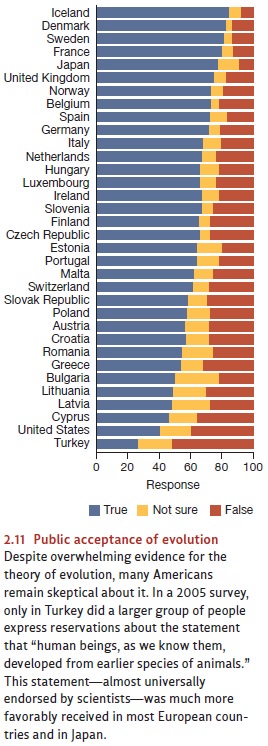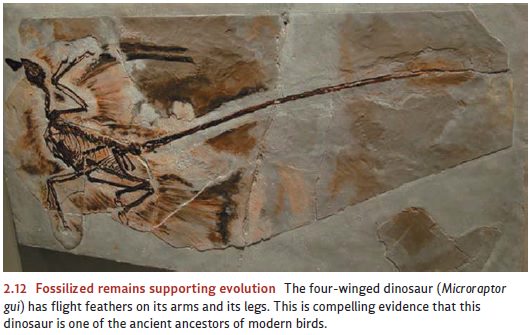Chapter: Psychology: The Genetic and Evolutionary Roots of Behavior
Evidence for Evolution by Natural Selection
Evidence for
Evolution by Natural Selection
Since Darwin’s day, thousands of
evolutionary biologists have contributed to the devel-opment of modern
evolutionary theory. Yet, around the globe, many nonscientists have misgivings
about evolution. According to one recent survey, only 40% of the people
surveyed in the United States said it’s true that “human beings, as we know
them, developed from earlier species of animals.” About a third of the people questioned
flatly rejected this statement (J. Miller, Scott, & Okamoto, 2006; for a
glimpse of the data in other countries, see Figure 2.11).

The situation is entirely
different, however, within the scientific community: Virtually every modern
scientist regards evolution as one of science’s best-documented, most firmly
established theories. Why are they so convinced? Scientists point to numerous
lines of evidence: We know (as Darwin did) that organisms can be trans-formed
by selective breeding; this is the way that botanists create new hybrid plants
and farmers create new breeds of cow. We understand in impressive detail how
genetic mutations arise, how genes are transmitted from generation to
generation, and how genes influence an organism’s traits. In addition, the
fossil record provides ample con-firmation of evolution’s claims, with the
bones of ancient species providing clear evi-dence for the various intermediate
organisms that existed during the process in which one lineage evolved into
another (Figure 2.12). Moreover, in many cases we can find anatomical leftovers
in modern species that reveal the evolutionary past of the species—for example,
the remnant hip and leg bones inside whales tell us that whales descended from
mammals that lived on land, and the human coccyx strongly indicates that humans
are descended from ancestors who had tails (Gingerich, Ul-Haq, Von Koenigswald,
Sanders, Smith et al., 2009). We can also examine the molecular struc-ture of
the genome in various organisms; this examination confirms the pattern of
relatedness among species and, indeed, lets us map out the likely “family tree”
of modern species.

We can also watch the process of
evolution unfolding in various populations. As one example, Lake Washington
(just east of Seattle) was cloudy and green for many years, thanks to the
exuberant growth of algae fed by treated sewage dumped into the water by
surrounding cities. This situation had a significant effect on the threespine
stickleback, a small fish living in the lake, because the murky water made it
difficult for predators—mostly cutthroat trout—to locate (and eat) the
sticklebacks (Kitano & Bolnick, 2008; also Hagen & Gilbertson, 1972;
Wallace, Gilbert, & King, 2001). During the 1960s, the cities around the
lake began to divert their sewage elsewhere, and by 1976 the water had cleared,
putting the sticklebacks at much greater risk of being eaten.
This change in circumstances had
a powerful impact on the sticklebacks. These fish vary in how much protective
“body armor” they carry: Some individuals have strong, bony

plates on their sides, and others
have much lighter plates (Figure 2.13). In the mid-1950s, there was little
predation (because the trout couldn’t see their prey in the murky waters), with
the result that the sticklebacks in Lake Washington needed little armor—and in
fact most of them had only light armor. As the waters cleared, though, these
unprotected fish became highly vulnerable to predators and fewer of them
survived long enough to breed. In contrast, the few fish that were more heavily
armored were much more likely to survive a predator’s attack, and so they lived
long enough to pass to their offspring the genes that had produced the heavy
armor. This is why a 2005 survey showed that almost all of Lake Washington’s
sticklebacks were either heavily or moderately armored; in contrast, the
lightly armored individuals—the clear majority 50 years ago—had become more
rare.
Related Topics